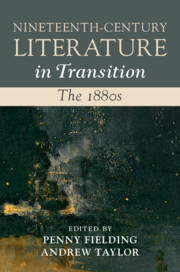Book contents
- Nineteenth-Century Literature in Transition: The 1880s
- Nineteenth-Century Literature in Transition
- Nineteenth-Century Literature in Transition: The 1880s
- Copyright page
- Contents
- Figures
- Contributors
- Acknowledgments
- Introduction: ‘Knowledge Made for Cutting’
- Chapter 1 Mermaids Amongst the Cables: The Abstracted Body and the Telegraphic Touch in the Nineteenth Century
- Chapter 2 Enclosing Forms, Opening Spaces: The 1880s Fixed-Verse Revival
- Chapter 3 ‘The Newest Culte’: Victorian Poetry and the Literary Societies of the 1880s
- Chapter 4 The Time of W.E. Henley: ‘Minor Poetry’ and the 1880s
- Chapter 5 The Evolution of Point of View
- Chapter 6 Network, History, Method: Andrew Lang in and after the 1880s
- Chapter 7 Animated Conversations: Form, Transformation and the Category of the Novel in the 1880s
- Chapter 8 Henry James, Vulgarity and Transatlantic Moderation
- Chapter 9 He and She: The 1880s, Camp Aesthetics and the Literary Magazine
- Chapter 10 Men, Women and Horses: Public Spectacle in 1887
- Chapter 11 The Secular Turn in British Literature of the 1880s
- Index
Chapter 2 - Enclosing Forms, Opening Spaces: The 1880s Fixed-Verse Revival
Published online by Cambridge University Press: 10 October 2019
- Nineteenth-Century Literature in Transition: The 1880s
- Nineteenth-Century Literature in Transition
- Nineteenth-Century Literature in Transition: The 1880s
- Copyright page
- Contents
- Figures
- Contributors
- Acknowledgments
- Introduction: ‘Knowledge Made for Cutting’
- Chapter 1 Mermaids Amongst the Cables: The Abstracted Body and the Telegraphic Touch in the Nineteenth Century
- Chapter 2 Enclosing Forms, Opening Spaces: The 1880s Fixed-Verse Revival
- Chapter 3 ‘The Newest Culte’: Victorian Poetry and the Literary Societies of the 1880s
- Chapter 4 The Time of W.E. Henley: ‘Minor Poetry’ and the 1880s
- Chapter 5 The Evolution of Point of View
- Chapter 6 Network, History, Method: Andrew Lang in and after the 1880s
- Chapter 7 Animated Conversations: Form, Transformation and the Category of the Novel in the 1880s
- Chapter 8 Henry James, Vulgarity and Transatlantic Moderation
- Chapter 9 He and She: The 1880s, Camp Aesthetics and the Literary Magazine
- Chapter 10 Men, Women and Horses: Public Spectacle in 1887
- Chapter 11 The Secular Turn in British Literature of the 1880s
- Index
Summary
Tracing the movement of print and literary forms in the later nineteenth century uncovers a complex transnatonality and intersectionality embedded in what might otherwise seem the most esoteric and confined of literary movements: the fixed-form verse revival of the late 1870s and 1880s. Reaching across national and temporal borders, the male coterie of Edmund Gosse, Austin Dobson, and Andrew Lang extolled villanelles, ballades, sestinas, rondeaux, and triolets as means to discipline contemporary English verse and delight connoisseurs. However, the movement did stay confined within elite class or gendered formations but infiltrated popular print in humorous penny weekly papers or political poems and also beckoned to women poets from A. Mary F. Robinson to Amy Levy to participate. Ultimately the fixed-form verse revival was a byproduct of a transatlantic literary market, so that the revival rested upon dynamic movements across bodies of water as well as across ostensible divides of nation, gender, and high versus popular culture.
Keywords
- Type
- Chapter
- Information
- Nineteenth-Century Literature in Transition: The 1880s , pp. 34 - 52Publisher: Cambridge University PressPrint publication year: 2019



